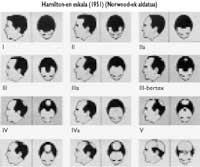Baldness of the baldness
Baldness or alopecia (or, what is the same, hair loss) is not usually a major health problem in most cases, but for the patient it is an aesthetic and psychological problem. The baldness is more complex than expected and in its etiology many and very different factors are mentioned, although according to last minute studies the origin of the process seems autoimmune.

The French dermatologist Raymond Sabouraud (1864-1938) defined that alopecia was the hair loss, which could occur in the skin of any part of the body, both extensively and in the form of plaque, and with or without scar. The word alopecia, etymologically, comes from the Latin alopex, and its meaning is the “fox” (animal that loses its coat twice a year; summer in autumn and winter in spring).
In the human species the hair is rather scarce, except in the scalp in axils or axils and in the pubis. But even if it is scarce, the hair of the head is a sign of beauty, both in men and women. And therefore, hair loss (and more specifically baldness) is usually frequent in a medical consultation.
There are many clinical forms of alopecia, and very different its etiopathogeny or its origin. Therefore, there is talk of endocrine alopecia, chemistry, infectious, metabolic, nervous, etc. Long. Of all, according to their frequency and importance, three types stand out: alopecia areata, androgenic alopecia and scar alopecia. In recent years, cases of universal alopecia have been described for the human immunodeficiency virus, HIV, in hiv-positive patients (in which it seems that alopecia would be a consequence of autoimmune phenomena).
Alopecia areata
In this type of baldness the hair is lost in well-defined areas (hence its name). Hair loss occurs in the form of plaque, in round or oval areas at first (focal alopecia), but can then be extended to the entire scalp (total alopecia) or to the entire body surface (universal alopecia). Along with hair loss, the remaining hair follicles also change from the growth phase (called anagen) to the resting phase (called telogen).

This type of baldness has the same effect on both sexes, but in countries like Italy or Spain the male/female relationship is one by two.
In the etiology of this process it seems that factors as diverse as genetic, atopies (in the form of allergy), immunological and emotional factors intervene.
From the clinical point of view, the initial lesion of this alopecia areata is a clearly delimited. The hairs at the edges of the lesion may appear thin and even broken. The evolution of the process can be very different. In some cases, the initial picture is normalized in a few months. On other occasions, after three or six weeks, other clearings appear that evolve cyclically. In some cases the initial hair loss is very widespread and complete. When the process heals, the new hair is usually fine and often without pigmentation, but gradually it recovers its size and normal color. However, it may occur that in some areas it is extended to others while sobriety is resolved.
Undoubtedly, alopecia areata has a poor prognosis if the hair loss is high or starts before puberty: in this case it is very difficult for the hair to reappear.
Androgenic alopecia
It is a physiological process that occurs in people genetically predisposed: instead of normal hair appears another thinner hair (without pigmentation) and then the hair falls.
Two types of androgenic alopecia are distinguished: one with male pattern or pattern and one with female pattern or pattern. Because the first appears more frequently, for a long time androgenic alopecia was called male, leaving out female androgenic alopecia. But this disease is not so scarce or rare: A quarter of women over the age of 50 are affected by androgenic alopecia, with rare onset of the disease in women before age 30. In men, on the other hand, half of those older than 50 years suffer from disease and 25% of those aged 25 to 30 years also.
The hair change is produced in a very special way (V. Figure 1), and the line of implantation of the hair in parietal pediment (or what is the same, the limit between the front and the hair) begins to recede while the hair is lost on the neck. In women, however, there is no regression and the hair is not completely lost, replacing normal hairs with much thinner hairs.
Androgenic baldness usually coincides with the reduction of the growth phase of pineapple or hair, increasing the proportion of telogenic hairs (i.e., hairs at rest). All this can be detected by a tricogram of hairs around the front, before highlighting the baldness. The abbreviation of the affected follicles, measured mainly in size and diameter of the hairs, is greater in women than in men.
Looking for the reason for androgenic alopecia, the hypothesis that is most mentioned today is that of testosterone. The prognosis of alopecia can be predicted in men, since the process is progressive, although the severity varies from one patient to another. In women, alopecia may improve after several months of treatment, but in the most severe cases, hirsutism or hair affection usually appears, which necessarily implies an endocrine study.
Traumatic alopecia
Baldness for physical trauma. Three are the main reasons:
- Trikotilomania, or pathological custom of throwing or pulling the hairs, already cited by Halloween in 1889.
- Alopecia cosmetic derived from the improper use of procedures and cosmetic products.
- Accidental alopecia due to an accident or mechanical trauma (easier to diagnose than the rest) suffering from the scalp.
Scar alopecia

With this general name are grouped those who accompany the destruction of the hair follicle, or those who give rise to such destruction. Due to disorders of the hair follicle or external causes, scars appear in the skin. The most common causes are infections (fungi, bacteria, or viruses), traumas (burns, radiodermitis), skin inflammations (of uncertain origin) (such as lupo), tumors (primary and even metastasis), and hereditary disorders (such as ichthyosis). However, the important thing will always be to diagnose or rule out a possible malignant grave associated with baldness in the case of scar allopecia.
And in the face of treatment, what?
To choose an effective treatment for baldness, it is necessary to know previously the etiological diagnosis, that is, the cause of baldness. And the differential diagnosis is based on a precise clinical history, with a rigorous view of personal and family pathologies, the control of the drugs taken by the patient, the dislocation of systemic and endocrine diseases, etc.
It is also important to take into account the details of hair loss: whether or not there are scaling phenomena, whether there are signs of inflammation or signs of healing, up to what number of hair lost, etc. On the other hand, tricogram can be of great utility for diagnosis, if it is valued by a specialist with extensive experience. For this purpose, with a carrier needle or pliers, a coleta of about 60 hairs is extracted after a week without washing the hair.
And in normal conditions we should find between 80% and 90% of the hairs in the growth phase (anagen), 10-20% in the resting phase (telogen) and a few catogenous hairs. Logically, cases that move away from these proportions will be assessed by the specialist. Other diagnostic methods are biopsy, culture, hormone research, and blood count.
Once the diagnosis is fixed, an adequate treatment will be ordered. In the case of alopecia areata, immunogutxantes, antiandrogens and forest extensors (minoxidil for example, although it is not yet known how it works) are used in androgenic alopecia, and in the rest of the calvicissitudes the treatment against the problem.
Surgery based on hair transplants can be useful in endoscopic alopecia, especially in patients who do not accept their simplicity (either for professional problems or because they do not like their appearance).
Figures and data for prevention Hair is something alive and in constant process of innovation, but unlike birds (which change the feathers to the low), hair loss in humans is a gradual process. The adult usually has about 100,000 hair follicles in the scalp (of which approximately 88% are in growth phase, 11% in rest and 1% in fall). The fall of about 100 hairs in a single day can be considered normal, while the rest of hairs grow about 0.45 millimeters. The hair also ages and with the passage of the years loses quantity, quality and strength. While a newborn has 1,135 follicles, they descend to 625 in the third decade of life and to 485 in the fifth. But the baldness does not come only from the amount of hair that is lost, but from the quality of what comes out. Hygiene is an economic and simple way of not recovering lost hair, but delaying the fall. Although classical dermatology stated that the hair is not much cleaned for a long time, it is necessary to wash it often with a soft shampoo. Patients can often go out against washing (as they realize they lose more by washing the hair), but the hair that falls is already dead and is not damaged by washing, but the reverse. |





